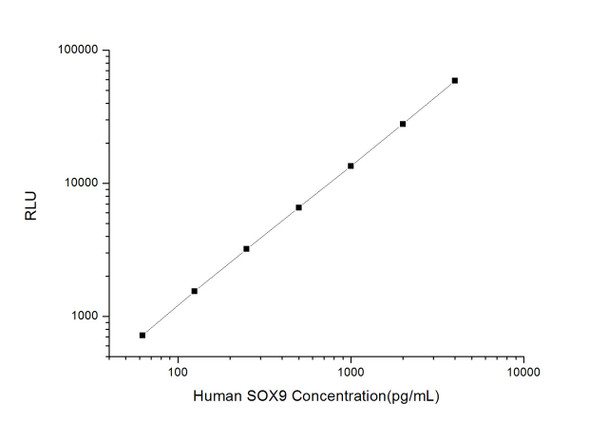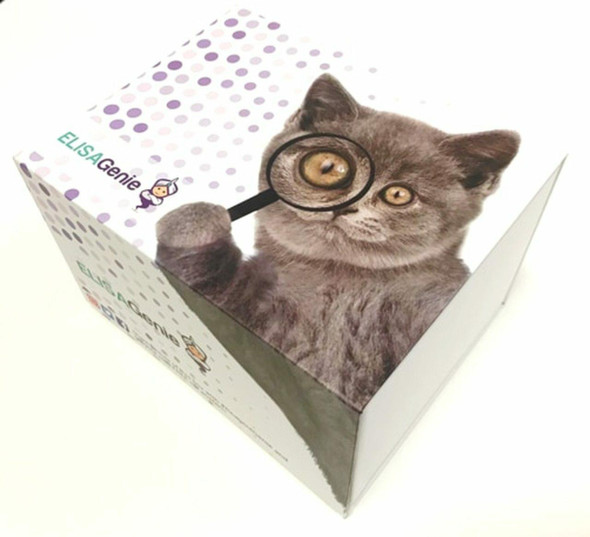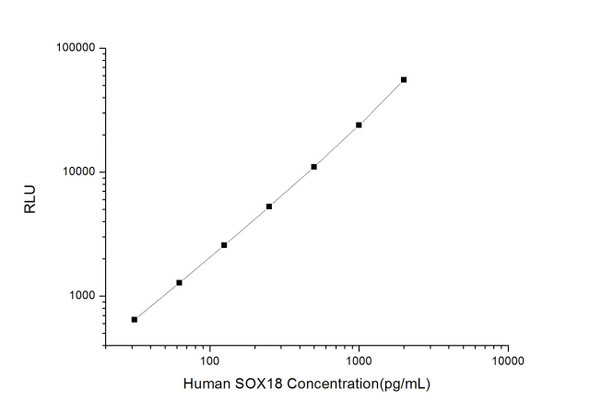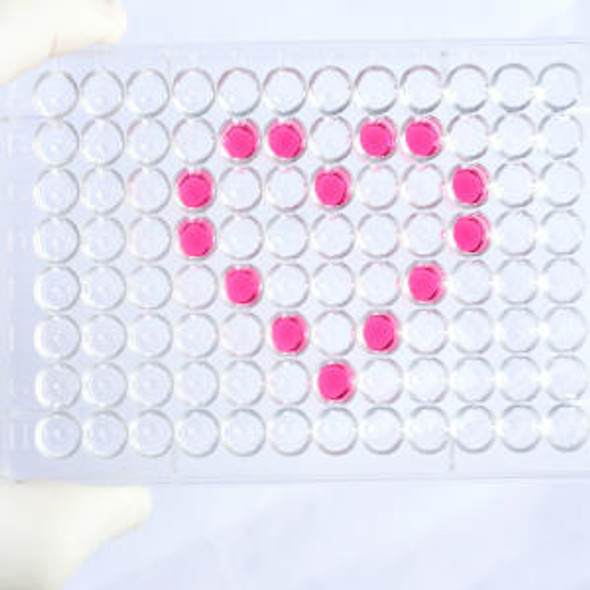Human Epigenetics and Nuclear Signaling ELISA Kits
Human SOX9 (Sex Determining Region Y Box Protein 9) CLIA Kit (HUES00785)
- SKU:
- HUES00785
- Product Type:
- ELISA Kit
- ELISA Type:
- CLIA Kit
- Size:
- 96 Assays
- Sensitivity:
- 37.5pg/mL
- Range:
- 62.5-4000pg/mL
- ELISA Type:
- Sandwich
- Reactivity:
- Human
- Sample Type:
- Serum, plasma and other biological fluids
- Research Area:
- Epigenetics and Nuclear Signaling
Description
| Assay type: | Sandwich |
| Format: | 96T |
| Assay time: | 4.5h |
| Reactivity: | Human |
| Detection method: | Chemiluminescence |
| Detection range: | 62.50-4000 pg/mL |
| Sensitivity: | 37.50 pg/mL |
| Sample volume: | 100µL |
| Sample type: | Serum, plasma and other biological fluids |
| Repeatability: | CV < 15% |
| Specificity: | This kit recognizes Human SOX9 in samples. No significant cross-reactivity or interference between Human SOX9 and analogues was observed. |
This kit uses Sandwich-CLIA as the method. The micro CLIA plate provided in this kit has been pre-coated with an antibody specific to Human SOX9. Standards or samples are added to the appropriate micro CLIA plate wells and combined with the specific antibody. Then a biotinylated detection antibody specific for Human SOX9 and Avidin-Horseradish Peroxidase (HRP) conjugate are added to each micro plate well successively and incubated. Free components are washed away. The substrate solution is added to each well. Only those wells that contain Human SOX9, biotinylated detection antibody and Avidin-HRP conjugate will appear fluorescence. The Relative light unit (RLU) value is measured spectrophotometrically by the Chemiluminescence immunoassay analyzer. The RLU value is positively associated with the concentration of Human SOX9. The concentration of Human SOX9 in the samples can be calculated by comparing the RLU of the samples to the standard curve.
| UniProt Protein Function: | SOX9: Plays an important role in the normal skeletal development. May regulate the expression of other genes involved in chondrogenesis by acting as a transcription factor for these genes. Defects in SOX9 are the cause of campomelic dysplasia (CMD1). CMD1 is a rare, often lethal, dominantly inherited, congenital osteochondrodysplasia, associated with male- to-female autosomal sex reversal in two-thirds of the affected karyotypic males. A disease of the newborn characterized by congenital bowing and angulation of long bones, unusually small scapulae, deformed pelvis and spine and a missing pair of ribs. Craniofacial defects such as cleft palate, micrognatia, flat face and hypertelorism are common. Various defects of the ear are often evident, affecting the cochlea, malleus incus, stapes and tympanum. Most patients die soon after birth due to respiratory distress which has been attributed to hypoplasia of the tracheobronchial cartilage and small thoracic cage. Defects in SOX9 are the cause of 46,XX sex reversal type 2 (SRXX2). SRXX2 is a condition in which male gonads develop in a genetic female (female to male sex reversal). |
| UniProt Protein Details: | Protein type:DNA-binding; Transcription factor Chromosomal Location of Human Ortholog: 17q24. 3 Cellular Component: nucleoplasm; nucleus; protein complex Molecular Function:chromatin binding; protein binding; protein kinase activity; RNA polymerase II transcription factor activity, enhancer binding; transcription factor activity Biological Process: cAMP-mediated signaling; cartilage condensation; cartilage development; cell fate specification; chromatin remodeling; epidermal growth factor receptor signaling pathway; epithelial to mesenchymal transition; hair follicle development; male germ-line sex determination; male gonad development; negative regulation of apoptosis; negative regulation of chondrocyte differentiation; negative regulation of epithelial cell proliferation; negative regulation of immune system process; negative regulation of myoblast differentiation; negative regulation of ossification; negative regulation of photoreceptor cell differentiation; negative regulation of transcription, DNA-dependent; nucleosome assembly; otic vesicle formation; positive regulation of cell proliferation; positive regulation of chondrocyte differentiation; positive regulation of epithelial cell differentiation; positive regulation of epithelial cell proliferation; positive regulation of mesenchymal cell proliferation; positive regulation of phosphoinositide 3-kinase cascade; positive regulation of protein amino acid phosphorylation; positive regulation of transcription from RNA polymerase II promoter; positive regulation of transcription, DNA-dependent; prostate gland development; protein complex assembly; regulation of apoptosis; regulation of cell proliferation; retina development in camera-type eye; Sertoli cell differentiation; signal transduction; skeletal development; somatic stem cell maintenance; spermatogenesis; tissue homeostasis Disease: 46,xy Sex Reversal 10; Campomelic Dysplasia |
| NCBI Summary: | The protein encoded by this gene recognizes the sequence CCTTGAG along with other members of the HMG-box class DNA-binding proteins. It acts during chondrocyte differentiation and, with steroidogenic factor 1, regulates transcription of the anti-Muellerian hormone (AMH) gene. Deficiencies lead to the skeletal malformation syndrome campomelic dysplasia, frequently with sex reversal. [provided by RefSeq, Jul 2008] |
| UniProt Code: | P48436 |
| NCBI GenInfo Identifier: | 1351096 |
| NCBI Gene ID: | 6662 |
| NCBI Accession: | P48436. 1 |
| UniProt Secondary Accession: | P48436,Q53Y80, |
| UniProt Related Accession: | P48436 |
| Molecular Weight: | 56,137 Da |
| NCBI Full Name: | Transcription factor SOX-9 |
| NCBI Synonym Full Names: | SRY-box 9 |
| NCBI Official Symbol: | SOX9 |
| NCBI Official Synonym Symbols: | CMD1; SRA1; CMPD1; SRXX2; SRXY10 |
| NCBI Protein Information: | transcription factor SOX-9 |
| UniProt Protein Name: | Transcription factor SOX-9 |
| Protein Family: | Transcription factor |
| UniProt Gene Name: | SOX9 |
| UniProt Entry Name: | SOX9_HUMAN |
As the RLU values of the standard curve may vary according to the conditions of the actual assay performance (e. g. operator, pipetting technique, washing technique or temperature effects), the operator should establish a standard curve for each test. Typical standard curve and data is provided below for reference only.
| Concentration (pg/mL) | RLU | Average | Corrected |
| 4000 | 57151 61011 | 59081 | 59046 |
| 2000 | 27571 28147 | 27859 | 27824 |
| 1000 | 14533 12435 | 13484 | 13449 |
| 500 | 6128 7082 | 6605 | 6570 |
| 250 | 3361 3125 | 3243 | 3208 |
| 125 | 1697 1465 | 1581 | 1546 |
| 62.50 | 720 790 | 755 | 720 |
| 0 | 33 37 | 35 | -- |
Precision
Intra-assay Precision (Precision within an assay): 3 samples with low, mid range and high level Human SOX9 were tested 20 times on one plate, respectively.
Inter-assay Precision (Precision between assays): 3 samples with low, mid range and high level Human SOX9 were tested on 3 different plates, 20 replicates in each plate.
| Intra-assay Precision | Inter-assay Precision | |||||
| Sample | 1 | 2 | 3 | 1 | 2 | 3 |
| n | 20 | 20 | 20 | 20 | 20 | 20 |
| Mean (pg/mL) | 182.45 | 482.85 | 1587.10 | 172.03 | 472.42 | 1434.04 |
| Standard deviation | 19.98 | 48.48 | 115.38 | 13.92 | 53.53 | 88.19 |
| C V (%) | 10.95 | 10.04 | 7.27 | 8.09 | 11.33 | 6.15 |
Recovery
The recovery of Human SOX9 spiked at three different levels in samples throughout the range of the assay was evaluated in various matrices.
| Sample Type | Range (%) | Average Recovery (%) |
| Serum (n=5) | 96-110 | 103 |
| EDTA plasma (n=5) | 87-101 | 93 |
| Cell culture media (n=5) | 85-100 | 92 |
Linearity
Samples were spiked with high concentrations of Human SOX9 and diluted with Reference Standard & Sample Diluent to produce samples with values within the range of the assay.
| Serum (n=5) | EDTA plasma (n=5) | Cell culture media (n=5) | ||
| 1:2 | Range (%) | 101-113 | 87-100 | 99-111 |
| Average (%) | 107 | 94 | 106 | |
| 1:4 | Range (%) | 84-97 | 92-105 | 89-102 |
| Average (%) | 91 | 98 | 95 | |
| 1:8 | Range (%) | 92-105 | 101-119 | 96-112 |
| Average (%) | 99 | 108 | 104 | |
| 1:16 | Range (%) | 100-117 | 93-106 | 103-115 |
| Average (%) | 108 | 99 | 109 |
An unopened kit can be stored at 4°C for 1 month. If the kit is not used within 1 month, store the items separately according to the following conditions once the kit is received.
| Item | Specifications | Storage |
| Micro CLIA Plate(Dismountable) | 8 wells ×12 strips | -20°C, 6 months |
| Reference Standard | 2 vials | |
| Concentrated Biotinylated Detection Ab (100×) | 1 vial, 120 µL | |
| Concentrated HRP Conjugate (100×) | 1 vial, 120 µL | -20°C(shading light), 6 months |
| Reference Standard & Sample Diluent | 1 vial, 20 mL | 4°C, 6 months |
| Biotinylated Detection Ab Diluent | 1 vial, 14 mL | |
| HRP Conjugate Diluent | 1 vial, 14 mL | |
| Concentrated Wash Buffer (25×) | 1 vial, 30 mL | |
| Substrate Reagent A | 1 vial, 5 mL | 4°C (shading light) |
| Substrate Reagent B | 1 vial, 5 mL | 4°C (shading light) |
| Plate Sealer | 5 pieces | |
| Product Description | 1 copy | |
| Certificate of Analysis | 1 copy |
- Set standard, test sample and control (zero) wells on the pre-coated plate and record theirpositions. It is recommended to measure each standard and sample in duplicate. Note: addall solutions to the bottom of the plate wells while avoiding contact with the well walls. Ensuresolutions do not foam when adding to the wells.
- Aliquot 100µl of standard solutions into the standard wells.
- Add 100µl of Sample / Standard dilution buffer into the control (zero) well.
- Add 100µl of properly diluted sample (serum, plasma, tissue homogenates and otherbiological fluids. ) into test sample wells.
- Cover the plate with the sealer provided in the kit and incubate for 90 min at 37°C.
- Aspirate the liquid from each well, do not wash. Immediately add 100µL of BiotinylatedDetection Ab working solution to each well. Cover the plate with a plate seal and gently mix. Incubate for 1 hour at 37°C.
- Aspirate or decant the solution from the plate and add 350µL of wash buffer to each welland incubate for 1-2 minutes at room temperature. Aspirate the solution from each well andclap the plate on absorbent filter paper to dry. Repeat this process 3 times. Note: a microplatewasher can be used in this step and other wash steps.
- Add 100µL of HRP Conjugate working solution to each well. Cover with a plate seal andincubate for 30 min at 37°C.
- Aspirate or decant the solution from each well. Repeat the wash process for five times asconducted in step 7.
- Add 100µL of Substrate mixture solution to each well. Cover with a new plate seal andincubate for no more than 5 min at 37°C. Protect the plate from light.
- Determine the RLU value of each well immediately.






